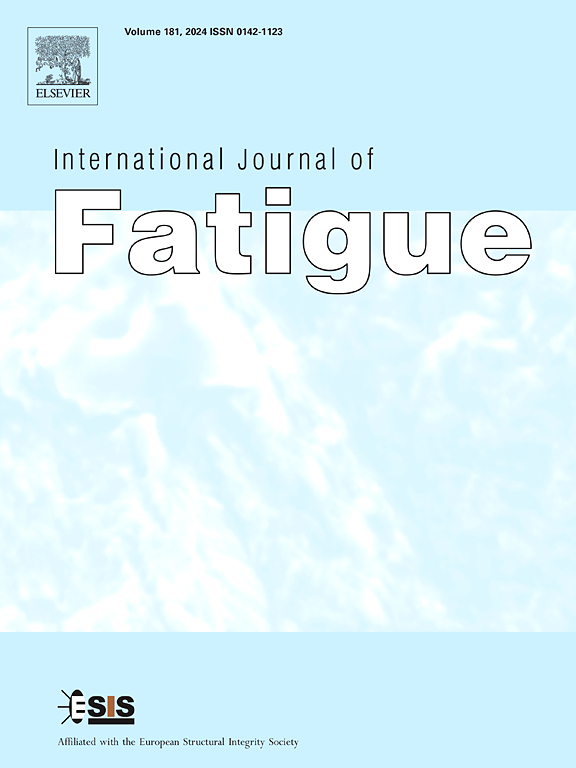Damage and microstructure evolution for rolling contact fatigue of a CSS-42L gear steel under mixed lubrication
IF 6.8
2区 材料科学
Q1 ENGINEERING, MECHANICAL
引用次数: 0
Abstract
In this study, a plasto-elastohydrodynamic lubrication model is employed to analyze the contact stress distribution in rolling contact fatigue (RCF) of a CSS-42L steel, which takes into account the effects of surface roughness and plastic deformation. Numerical simulation reveals that the maximum von Mises stress occurs at subsurface and it is not significantly affected by the presence of lubricating oil due to the relatively low surface roughness of the sample. The experiments are conducted under a mixed lubrication state, i.e., the hydrodynamic lubricant film and rough surface asperity contact coexists. Numerical analysis further indicates that the hydrodynamic lubricant film dominates the contact zone. It is supported by experimental observations that subsurface spalling pits are the main cause for the RCF failure in CSS-42L steel. In contrast, the oxidative wear damage from solid-solid asperity contact primarily leads to micro-pitting on the sample surface. Microstructure characterization indicates that the high-density carbide effectively impedes the RCF crack growth by influencing the path of crack propagation. The refinement of microstructure is also observed during the RCF, which is attributed to the cyclic plastic deformation caused by repetitive high contact stress.

混合润滑下CSS-42L齿轮钢滚动接触疲劳损伤及组织演变
在考虑表面粗糙度和塑性变形影响的情况下,采用弹流力学润滑模型分析了CSS-42L钢滚动接触疲劳(RCF)过程中的接触应力分布。数值模拟表明,最大von Mises应力发生在地下,由于样品表面粗糙度相对较低,因此受润滑油存在的影响不大。实验是在混合润滑状态下进行的,即流体动力润滑膜与粗糙表面的粗糙度同时存在。数值分析进一步表明,流体动力润滑膜在接触区占主导地位。实验结果表明,地下剥落坑是导致CSS-42L钢RCF破坏的主要原因。而固-固粗度接触引起的氧化磨损损伤主要导致试样表面出现微点蚀。显微组织表征表明,高密度碳化物通过影响裂纹扩展路径有效地阻碍了RCF裂纹扩展。在RCF过程中也观察到微观组织的细化,这是由于重复的高接触应力引起的循环塑性变形。
本文章由计算机程序翻译,如有差异,请以英文原文为准。
求助全文
约1分钟内获得全文
求助全文
来源期刊

International Journal of Fatigue
工程技术-材料科学:综合
CiteScore
10.70
自引率
21.70%
发文量
619
审稿时长
58 days
期刊介绍:
Typical subjects discussed in International Journal of Fatigue address:
Novel fatigue testing and characterization methods (new kinds of fatigue tests, critical evaluation of existing methods, in situ measurement of fatigue degradation, non-contact field measurements)
Multiaxial fatigue and complex loading effects of materials and structures, exploring state-of-the-art concepts in degradation under cyclic loading
Fatigue in the very high cycle regime, including failure mode transitions from surface to subsurface, effects of surface treatment, processing, and loading conditions
Modeling (including degradation processes and related driving forces, multiscale/multi-resolution methods, computational hierarchical and concurrent methods for coupled component and material responses, novel methods for notch root analysis, fracture mechanics, damage mechanics, crack growth kinetics, life prediction and durability, and prediction of stochastic fatigue behavior reflecting microstructure and service conditions)
Models for early stages of fatigue crack formation and growth that explicitly consider microstructure and relevant materials science aspects
Understanding the influence or manufacturing and processing route on fatigue degradation, and embedding this understanding in more predictive schemes for mitigation and design against fatigue
Prognosis and damage state awareness (including sensors, monitoring, methodology, interactive control, accelerated methods, data interpretation)
Applications of technologies associated with fatigue and their implications for structural integrity and reliability. This includes issues related to design, operation and maintenance, i.e., life cycle engineering
Smart materials and structures that can sense and mitigate fatigue degradation
Fatigue of devices and structures at small scales, including effects of process route and surfaces/interfaces.
 求助内容:
求助内容: 应助结果提醒方式:
应助结果提醒方式:


